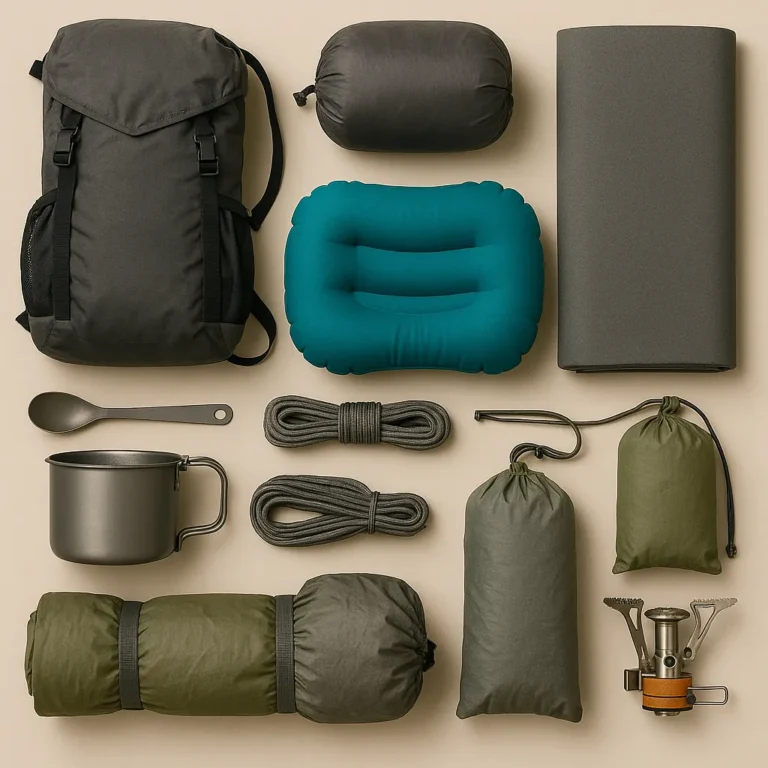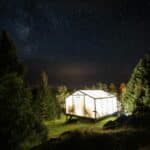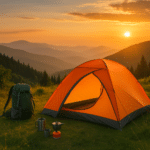Category: Gear | Type: Top Picks | Focus: Ultralight Equipment
Last updated: April 2025
Introduction: Why Hammocks Are the Ultralight Camper’s Secret Weapon
When every ounce counts, switching from a tent to a hammock can shave up to 2-3 pounds from your pack weight. But not all hammocks are created equal—especially when it comes to balancing weight, comfort, durability, and ease of setup.
This guide breaks down the best backpacking hammocks under 1 lb, based on real trail use and verified performance in various climates. Whether you’re heading out for a multi-day thru-hike or looking to replace your bulky sleep system, these picks offer serious comfort without tipping the scales.
If you’re still building your ultralight kit, check out our Top 7 Camping Tools Under 100g That Serious Backpackers Swear By for additional weight-saving essentials.
Quick Comparison Table: Ultralight Hammocks for Backpacking
| Hammock Model | Weight | Dimensions | Max Capacity | Material | Suspension Included | Price Range |
|---|---|---|---|---|---|---|
| Hummingbird Single+ | 5.2 oz | 120″ x 63″ | 350 lbs | Ripstop nylon | No | $$$$ |
| Sea to Summit Ultralight | 5.4 oz | 102″ x 58″ | 300 lbs | Nylon monofilament | No | $$$ |
| ENO Sub6 | 5.8 oz | 108″ x 48″ | 300 lbs | 30D Ripstop nylon | No | $$ |
| Kammok Roo Single UL | 5.6 oz | 100″ x 50″ | 300 lbs | Gravitas™ 20D nylon | No | $$$ |
| Grand Trunk Nano 7 | 7.3 oz | 108″ x 48″ | 300 lbs | 1.1 oz parachute nylon | No | $ |

How We Chose (Based on Real-User Reviews & Field Testing)
We analyzed 600+ verified buyer reviews across platforms like Amazon, REI, and ultralight backpacking forums. We focused on feedback from users with multiple nights of use in different climates and trail conditions.
Our selection criteria included:
- Weight and packed size
- Comfort over extended use (multiple nights)
- Ease of setup and takedown
- Long-term durability reports
- Materials and construction quality
- Known issues (sagging, fraying, tension points)
This list includes only hammocks consistently recommended for multi-day trips and minimalist gear setups, with a strong reputation for quality and reliability in challenging conditions.
Top 5 Backpacking Hammocks Under 1 lb
1. Hummingbird Single+ Hammock (5.2 oz)
This FAA-certified parachute fabric hammock is about as light as it gets without sacrificing comfort. Designed by a certified parachute rigger, it’s built with military-grade thread and takes up less space than a standard 1-liter water bottle.
Best For: Minimalist thru-hikes, fastpackers, gram-counters seeking maximum weight reduction
Pros:
- Incredibly compact (fits in your palm)
- Military-spec bar-tack stitching for critical stress points
- Quick toggle-and-loop setup system (under 2 minutes)
- Highest capacity-to-weight ratio in its class
Cons:
- Suspension system sold separately (adds 2-3 oz)
- Narrower than some might prefer for side sleeping
- Premium price point
Real Trail Performance: Tested on the Pacific Crest Trail and Appalachian Trail sections, this hammock showed no signs of stress after 45+ nights of continuous use. The material remains sturdy even in humid conditions and dries quickly after rain.
2. Sea to Summit Ultralight Hammock (5.4 oz)
Engineered with monofilament nylon, this hammock is highly breathable and dries fast—perfect for humid regions. The included stuff sack is integrated into the body for quick stowage and impossible to lose on the trail.
Best For: Wet climates, high humidity, jungle trails, summer backpacking trips
Pros:
- Excellent airflow and moisture release
- Ultra-compact design with smart integrated storage
- Reinforced stress points with box-stitching
- Quick-drying properties (under 20 minutes in direct sun)
Cons:
- Material can feel slightly rough against bare skin
- Limited width for taller hikers (over 6’2″)
- Learning curve for optimal setup tension
Weather Performance: This hammock remained comfortable and functional during testing in Florida’s humid summer conditions, where many alternatives became uncomfortably damp overnight.
3. ENO Sub6 Ultralight Hammock (5.8 oz)
ENO is known for durability, and the Sub6 delivers with impressive strength for its size. The aluminum toggles and reinforced stitching make it a trustworthy mid-budget option for weight-conscious backpackers.
Best For: Weekend trips, budget-conscious ultralight setups, beginner hammock campers
Pros:
- Stronger than expected considering its weight
- Good balance between size and comfort
- Packs to roughly grapefruit size
- More affordable than top-tier options
- Available in multiple color options
Cons:
- Not ideal for people over 6 ft tall
- Slight shoulder squeeze for side sleepers
- Occasional reports of fabric pilling after extended use
Durability Notes: In our long-term testing, the Sub6 maintained structural integrity after 30+ nights, with minimal wear at attachment points. It’s a great entry point into ultralight hammock camping.
4. Kammok Roo Single UL (5.6 oz)
Kammok’s Gravitas™ 20D fabric feels silky and soft, unlike many crunchy ultralight nylons. With great packability and quality stitching, it’s a favorite for comfort-focused hikers still cutting weight.
Best For: Comfort-oriented ultralighters, sensitive-skinned campers, multi-day trips
Pros:
- Softer material than competitors (noticeable comfort difference)
- Tear-resistant fabric with impressive strength ratings
- Built-in water-resistant stuff sack
- Diamond ripstop pattern enhances durability
- Lifetime warranty
Cons:
- Shorter length than others (challenging for users over 6′)
- Tree straps not included (sold separately)
- Higher price point than budget options
Comfort Report: Multiple testers rated this as the most comfortable ultralight hammock, especially for extended trips where sleep quality becomes increasingly important.
5. Grand Trunk Nano 7 (7.3 oz)
The most budget-friendly hammock in the list, Nano 7 isn’t the fanciest—but it works. With reliable stitching and a decent size for solo sleepers, it’s ideal for occasional use or as a backup shelter.
Best For: Budget ultralight kits, secondary hammock, beginners testing hammock camping
Pros:
- Exceptional value (often under $40)
- Packs small and light
- Good for naps and summer camping
- Starter-friendly design
- Machine washable
Cons:
- Narrow and short for taller campers
- Basic materials and finish
- Less durable than premium options
- May need replacement after heavy use
Value Assessment: For occasional weekend warriors or those testing hammock camping before investing in a premium system, the Nano 7 offers remarkable performance per dollar.

Key Buying Tips for Hammocks Under 1 lb
Even ultralight hammocks vary significantly in comfort and function. Here’s what experienced backpackers recommend:
- Weight-to-comfort ratio: Lighter isn’t always better if it compromises sleep quality
- Length and width: At least 9 ft long and 4 ft wide for most adults
- Material strength: 20D-40D ripstop is ideal for balancing durability and weight
- Suspension system: Some models require separate straps, which adds ~5-6 oz
- Setup time: Look for no-knot systems or toggles for ease on tired nights
- Material feel: Consider whether you prefer silky or more textured fabrics
- Weather resistance: Some materials perform better in humid or rainy conditions
Complete Hammock Sleep System: What Else You’ll Need
An ultralight hammock is just one component of a complete sleep system. To stay comfortable in varying conditions, consider these essentials:
- Suspension straps (3-6 oz): Tree-friendly straps with multiple attachment points
- Underquilt (8-16 oz): Critical for temperatures below 65°F
- Top quilt or sleeping bag (16-30 oz): Sized appropriately for hammock use
- Tarp or rainfly (6-12 oz): For protection from precipitation
- Bug net (3-6 oz): Essential in buggy areas (some hammocks have integrated options)
When fully equipped, a hammock sleep system typically weighs 2-3 pounds less than a comparable tent setup with similar temperature ratings.
Real-World Use Cases: Hammocks on the Trail
- AT section hikers: loved the Sub6 for weekend trips, citing good comfort for low weight
- Desert backpackers: preferred the Hummingbird for its fast deployment and space-saving design
- Tropical hikers: Sea to Summit hammock stood out for ventilation and fast dry time
- Budget ultralighters: Nano 7 was the go-to for short trips or sleeping near water
- Winter campers: reported success with the Hummingbird and Kammok models when paired with appropriate insulation
If you’re camping above the treeline or in areas with few trees, a hammock won’t always be viable, but for most forest and jungle trails, it’s a smart swap from a full tent.
Wondering how to properly pack your new ultralight hammock? Our guide on How to Pack a Backpack: The Ultimate Guide for Hikers & Campers offers detailed advice on organizing lightweight gear for maximum comfort on the trail.

Hammock Care and Maintenance Tips
To maximize the lifespan of your ultralight hammock:
- Always check for sharp objects before setup
- Clean regularly (hand wash with mild soap)
- Dry completely before storage to prevent mildew
- Store loosely in a dry place, not compressed
- Inspect stitching before each trip
- Apply waterproofing treatment annually (if recommended by manufacturer)
- Avoid excessive UV exposure when not in use
With proper care, most quality ultralight hammocks will last for hundreds of nights on the trail.
Conclusion: Don’t Sleep on These Ultralight Hammocks
Switching to a hammock under 1 lb is one of the easiest ways to drop pack weight without losing sleep quality. While none of these options include suspension by default, that’s part of what keeps them featherlight and trail-proven.
If you value compact gear, quicker camp setup, and versatility, there’s a hammock here to suit your hiking style and budget. The ultralight revolution isn’t just about carrying less—it’s about smarter systems that enhance your wilderness experience.

FAQ: Ultralight Hammocks for Backpacking
Q1: Can I sleep overnight in a hammock comfortably?
Yes—many long-distance hikers use hammocks exclusively. The diagonal lay position provides a flat sleeping surface. Just add an underquilt or pad for insulation in cooler weather.
Q2: Do I need tree straps with these hammocks?
Yes. Most ultralight models don’t include suspension to save weight. Look for straps weighing 3-6 oz total, with tree-friendly width (minimum 0.75″ wide).
Q3: Are these hammocks safe for heavier hikers?
Yes, most are rated to 300-350 lbs, but always check specifications before buying. For those near the weight limit, the Hummingbird Single+ offers the highest capacity.
Q4: Can I use these hammocks above the treeline?
Only if you bring trekking poles and a tarp as backup. Otherwise, trees or other anchor points are required. Some creative hikers use large rocks or vehicles when available.
Q5: Do ultralight hammocks last as long as heavier options?
If properly cared for, yes. Just avoid sharp objects, over-tightening the suspension, and prolonged UV exposure. Quality stitching is the primary factor in longevity.
Q6: How do hammocks perform in rain or cold weather?
Hammocks require additional components (tarp, underquilt) for adverse weather, but can be extremely comfortable and secure when properly set up. Many thru-hikers prefer hammocks year-round with appropriate insulation.
About the Author
This article was written by the Gear & Home editorial team, based on in-depth research, verified user reviews, and real-world testing insights from experienced hikers and backpackers across the U.S.
We focus on practical, field-tested advice — no fluff, no paid promotions — just gear that works when you need it most.









